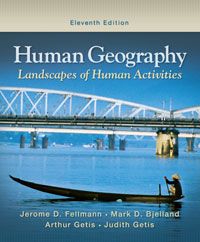1 A) natural change and crude birth rates. B) natural change and dependency ratios. C) net migration and dependency ratios. D) net migration and natural change. 2 A) in the first stage of the demographic cycle with high fertility rates. B) with high birth rates. C) with imbalanced fertility rates and dependency ratios. D) with a continuing imbalance between numbers of people and carrying capacity. 3 A) education and literacy rates B) government policies regarding population growth C) stage of demographic transition D) the status of women 4 A) decreased arithmetic density but increased physiological density. B) decreased both arithmetic and physiological densities. C) increased arithmetic density but decreased physiological density. D) increased both arithmetic and physiological densities. 5 A) an immediate end to population growth will occur when the replacement rate reaches 2.1. B) any child born today will have a life expectancy of at least 75 years. C) our older populations will continue to live longer due to advances in technology. D) the consequences of high fertility rates among young people will be realized as they work their way through the population pyramid. 6 A) Stage 1 B) Stage 2 C) Stage 3 D) Stage 4 7 A) 3 billion persons. B) 6.7 billion persons. C) 9.8 billion persons. D) 11 billion persons. 8 A) been reduced to zero. B) decreased. C) increased. D) remained the same. 9 A) 1.0 B) 2.1 C) 3.7 D) 5.8 10 A) 500,000 births and 400,000 deaths B) 50,000 births and 40,000 deaths C) 50,000 births and 10,000 deaths D) 500,000 births and 10,000 deaths 11 A) Africa. B) Europe. C) North America. D) South America. 12 A) Carrying capacity is the number of people an area can support given current technological conditions. B) Overcrowding is a reflection of population per unit area. C) Overpopulation is a value judgment. D) Underpopulation occurs when a country has too few people to develop its resources. 13 A) a greater use of contraceptives. B) access to educational facilities. C) the pronounced youthfulness of their populations. D) the very high birth rates. 14 A) changes in human dietary patterns. B) changes in technology. C) the discovery of new inhabitable regions. D) war and diseases. 15 A) decline. B) rapid growth. C) slow growth. D) stability. 16 A) developing rural nations. B) South and Central America. C) the urbanized areas of South Asia. D) urbanized industrial nations. 17 A) middle-aged families with two or more children. B) young families. C) retirees. D) young single adults. 18 A) drastically reduced death rates in developing countries without simultaneous and compensating reductions in births. B) government policies in Europe attempting to repopulate the war-torn countries. C) massive industrialization attempts in both developing and developed countries. D) the heavy death toll during the war with fewer births occurring. 19 A) Africa. B) Asia, excluding India and China. C) China. D) India. 20 A) East Asia, South Africa, Europe, North America. B) East Asia, South Asia, Europe, Africa. C) East Asia, South Asia, Europe, North America. D) East Asia, South Asia, North America, South America. 21 A) the total numbers of births and deaths can never be calculated accurately. B) they relate to the changes without any regard to the age or sex composition of the population. C) the infant mortality rate is separate from the birth and death calculations. D) there is no worldwide standard of what constitutes a birth or a death. 22 A) birth rate. B) infant mortality rate. C) maternal mortality rate. D) death rate. 23 A) suitable as predictions. B) based on assumptions for the future using current data. C) used for assessing crude death rates. D) used only for countries that have annual censuses. 24 A) Canada. B) South Africa. C) South America. D) Western Europe.





